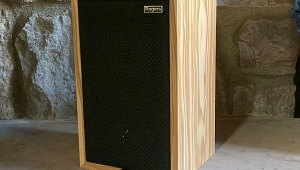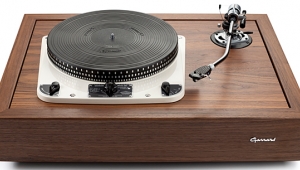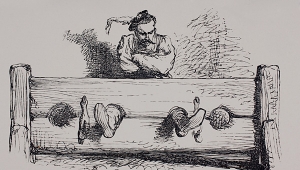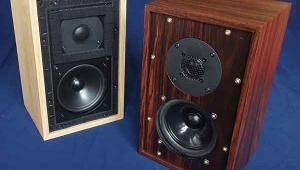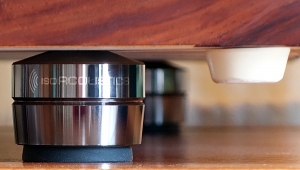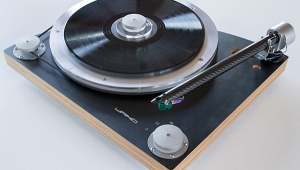| Columns Retired Columns & Blogs |
Listening #136
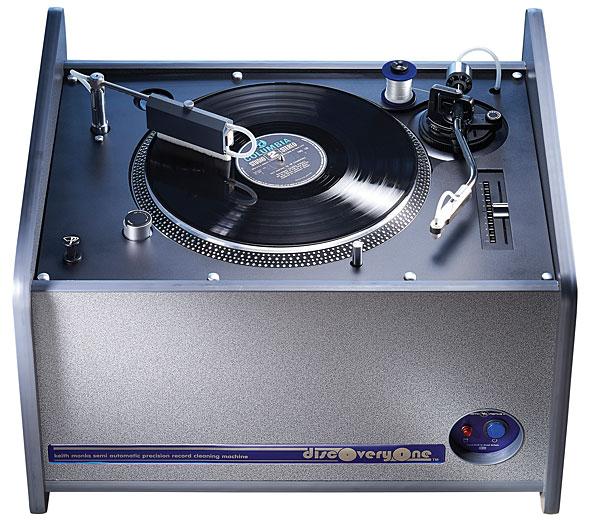
"Perhaps we can shed some light on your problem in a new segment exploring pre-adolescent turmoil. I call it . . . 'Choices.'"—Sideshow Bob, The Simpsons
Footnote 1: Keith Monks Audio Works, PO Box 34, Ventnor, Isle of Wight PO38 1YQ, England, UK. Tel: (44) (0)1983-857079. Web: www.keithmonks-rcm.co.uk. US distributor: Keith Monks America, PO Box 771, Mequon, WI 53092. Tel: (413) 539-4378.
"For us, unlike other manufacturers, there are not degrees of clean. Our entry-level machine is as good as our top of our line when it comes to cleaning records; in between, it's just a matter of choices." Thus spoke Jonathan Monks, who inherited from his father, the late Keith Monks, an audio-manufacturing legacy built upon the world's first commercially produced record-cleaning machine.
Our conversation was prompted by last year's introduction of the discOveryOne ($2495), the most affordable record-cleaning machine yet from Keith Monks Audio Works (footnote 1). The new model achieves this level of thrift in two ways: Rather than being fitted with the proprietary platter, motor drive, and vacuum arm of other KMAW machines, the discOveryOne is built around a modified Citronic PD-1 Mk.3 direct-drive turntable (footnote 2) and tonearm; and the new machine omits the automated fluid-dispensing and record-scrubbing systems used in KMAW's previous models. The former is an obviously less expensive way of doing things (though it may raise a few eyebrows among the faithful), while the latter is perfectly in keeping with the manner in which I use my own, far older Monks record cleaner, having long ago decided that I'm better than any machine at wetting and scrubbing records. (Sucking up solubilized dirt remains beyond my capabilities.)
I find it much easier to dispense the precisely correct amount of fluid onto a record's surface from a manual squeeze bottle, and manual scrubbing allows me to vary the pressure with which I scrub each LP, and to scrub especially dirty records using a rapid back-and-forth motion. Let's see any machine do that.
Indeed, I expressed those thoughts to Jonathan Monks back in 2009, when he gave me the opportunity to write about the newly revived company's first product, the Keith Monks Omni RCM Mk.VII ($6495). That model proved to be the best record-cleaning machine I'd tried, but it was priced far beyond my means—a sad thing to ponder, in the unfortunate event that my own RCM is ever recalled by the friend who loaned it to me.
Agitate, agitate, agitate
The borrowed RCM remains in place, yet a number of other things have changed since 2009. Keith Monks Audio Works has reasserted itself in the professional marketplace, which is the company's traditional strong suit. (Since 1969, KMAW has sold thousands of record-cleaning machines—to the BBC, the British Library, the U.S. Library of Congress, and myriad independent libraries, broadcast stations, universities, and record stores.) The domestic market for four-figure record-cleaning machines has seen a recent, healthy uptick, as one can observe in the success of the Audiodesk Systeme Glass Vinyl Cleaner ($3995; respectively reviewed by Michael Fremer and Fred Kaplan in the June 2012 and September 2013 issues) and its ultrasonic ilk. And, perhaps most important, the market for new and used vinyl has continued to grow, with no sign of slowing.
Thus the stage is set for the discOveryOne—which, like every other KMAW machine, owes its existence to the late Percy Wilson, technical editor (who died in 1977) of Gramophone magazine, whose writings became a roadmap of sorts for a record-cleaning machine industry that didn't yet exist. Wilson's design, intended only for professional use (footnote 3), was a titanically complex device called the Record Doctor, in which various appliances—a wetter, a scrubber, a "suction mop," and a spinning brush that acted as both a blow-dryer and a polisher—were applied to and retracted from a spinning disc, radially and in sequence. A radial heat lamp was added to confer the possible extra benefit of warp correction, and the recommended cleaning fluid was filtered rainwater, preferably heated to 120°F. (Earlier Wilson fluid recipes called for vinegar and, for really badass records, ethyl alcohol.)
Percy Wilson's contributions to our understanding of audio engineering in general and of phonography in particular were of considerable value, so it is with the greatest delicacy that I suggest that the Record Doctor, as originally conceived and prototyped, was a bit nutty. Fortunately, some engineers whom he brought in as collaborators—including John Wright, Mike Beville, Frank Ockenden, and Pete Keeley—pushed for a simpler and, ultimately, more effective design. The heat lamp and the spinning brush got the heave-ho, and the radial suction mop was replaced with a pivoting arm that was connected, by means of flexible tubing, to a medical-spec vacuum pump. A geared motor and a belt-drive pulley, hidden beneath the top plate, moved the arm at a speed of about 4" per minute across a record spun at 80rpm, both speeds having been determined by Wilson to offer the best hedge against premature evaporation.
The final touch: After Wilson and his collaborators noted that the vacuum arm wasn't removing all the cleaning fluid after a single pass, they hit on the idea of spooling a length of nylon sewing thread into the vacuum collection system, such that a tiny bit of thread is always squeezed between the record's surface and the nylon nozzle of the vacuum arm. Not only does the thread confer some welcome cushioning, it creates just enough of a gap between record and nozzle to enhance the vacuum effect. (Contrary to other reviews, this element does not exert a scrubbing or "wicking" effect, seeing as how a thread can no more fit into a record groove than a tree trunk can fit into a hotdog bun.) Yet another gear-driven motor was used to slowly but continually spool fresh thread into the system—the vacuum system took up the slack and disposed of spent thread with matching constancy—thus ensuring that the record was never recontaminated with its own filth: an important concern, in my opinion. This enhancement in particular made Wilson's contraption reliably effective, thus paving the way for its commercial production and sale by the aforementioned Keith Monks. The rest is history.
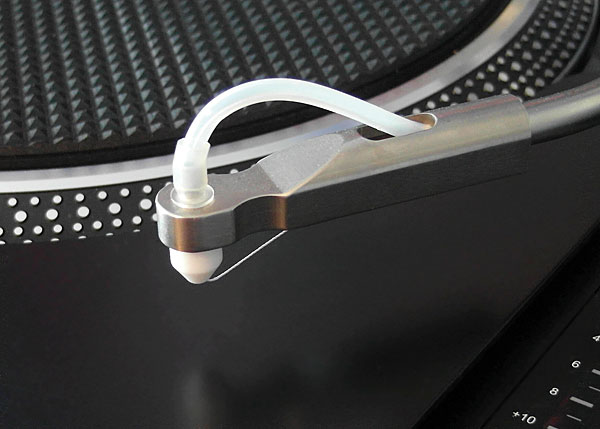
A close-up of Monks's new vacuum nozzle (Photo: Art Dudley)
You'll have gathered that I regard the Keith Monks vacuum-drying system as the most crucial and, indeed, most impressive part of the system. Automated washing is a welcome and mildly entertaining luxury, but let's face it: As with appliances designed for the washing of dishes and clothing, most actual cleaning is done chemically. Soap and detergent molecules, which are polarized, have the dual characteristics of being able to attach themselves to certain contaminants, and of being able, through hydrogen bonding, to combine with water molecules, which are also polarized. Thus, apart from those small gestures that can enhance the soap-dirt bond—chief among them agitation—most of the work being done here is the removal of the water containing the solubilized contaminants. Or, to put it another way, most of the washing is accomplished in the rinsing and drying. So let's do it well.
I labor not
Fast-forward to today: How did my review sample of the discOveryOne stack up against Keith Monks models of yore? There were some obvious working differences, the most notable being that the discOveryOne's platter spins at a much slower 331/3rpm. I was mildly surprised that it wasn't set at 45rpm—of which the OEM turntable is also capable—and even more surprised that KMAW left in place the turntable's sliding-knob pitch control. As for the latter, Jonathan Monks takes a lighthearted view: "I think we're wearing the origins of that deck on our sleeve, and we'd have to pay someone to remove [the pitch control]. So we thought, well, why not leave it in—that, and the light that would normally illuminate the stylus of a deejay deck on the dance floor—for a bit of fun?" On the other hand, the microswitch that automatically sets the Citronic's platter spinning when the tonearm is moved from its rest has been put to excellent use: When the discOveryOne's vacuum arm returns to its resting position after drying the record, from inner groove to outer, the vacuum pump is automatically powered off.
Footnote 1: Keith Monks Audio Works, PO Box 34, Ventnor, Isle of Wight PO38 1YQ, England, UK. Tel: (44) (0)1983-857079. Web: www.keithmonks-rcm.co.uk. US distributor: Keith Monks America, PO Box 771, Mequon, WI 53092. Tel: (413) 539-4378.
Footnote 2: It appears to be a copy of a Technics SL-1200.
Footnote 3: Percy Wilson also invented the Record Player Cleaner, which was slightly more appropriate for domestic use if still far frompractical. Configured as a pivoting rather than a radial arm, the RPC was intended to damp-clean and then instantly dry a small portion of the groove at a time, a second or two before that portion reached the stylus.
- Log in or register to post comments


